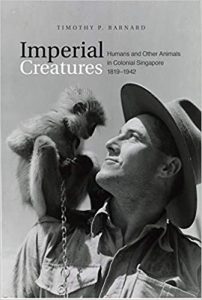Humans and Other Animals in Colonial Singapore
October 6, 2020

The United Nations designated World Habitat Day on the first Monday of October as a day to reflect on the future of the human habitat, and the basic right of all people to adequate shelter. The day is also intended to remind the world of its collective responsibility towards protecting our towns and cities.
A/P Timothy P. Barnard’s (NUS Department of History) book, Imperial Creatures: Humans and Other Animals in Colonial Singapore, 1819-1942 (NUS Press, 2019), examines the effects of imperialism across animal species in a colonial society. The book thus follows the history of how animals used to interact with humans, revealing the structures of imperial rule and its effects on the biodiversity in Singapore. By doing so, the book moves beyond a rigid consideration of Singapore’s history through the lens of politics, economics, and military endeavours, seeking to uncover new perspectives by exploring the history of animals on the island.
In the first chapter, “Animals, Empire and Singaporean History”, A/P Barnard explains that his book is part of the larger trend of animal studies in academic discourse, which became the focus of scholarship in the late 20th century. Though much of the work of animal studies in Southeast Asia focuses on charismatic megafauna like tigers or elephants, A/P Barnard’s work chooses instead to follow more common animals like dogs, cattle, and horses. As a result, by tracing accounts of these animals and how they were cherished, slaughtered, monitored, or employed, the book exposes the elements of imperialism and how its imposition was achieved.
The chapter details how the rest of the book continues to explore the human-animal relationship that helped to shape imperial rule in Singapore. For instance, Chapter Five “Domestication, Regulation and Control of Dogs, and Other Animals”, identifies how rabies in the late 19th century came to affect the perception of domestic pets, and how they were regulated and monitored in society. Chapter Six charts how animals were used as objects of consumption through the development of a system of modern markets and slaughterhouses that examined and processed animals for slaughter, considered a model of modern imperial rule and sanitation. Crucially, the book thus exemplifies how all animals had played an integral part in the creation of an imperial society in Singapore.
The book is available here.
